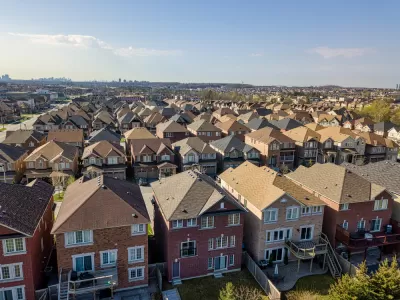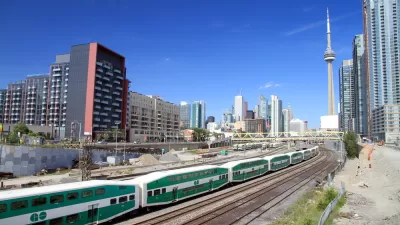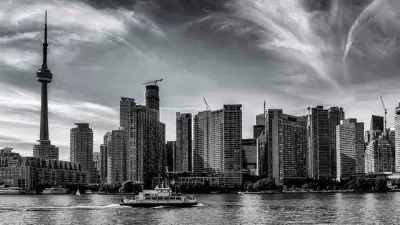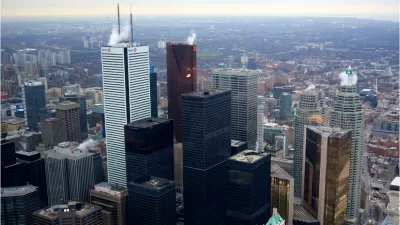The architecture critic for the Globe and Mail finds fault with two massive development proposals in the Toronto suburbs.

Alex Bozikovic, architecture critic for the Globe and Mail, writes about what he calls "a bit of Hong Kong in the 905"—the conceptual renderings for two new 'transit-oriented communities' in the Toronto suburbs of Richmond Hill and Markham.
"Drawings show forests of shimmering, skinny towers dropped into a flat suburban landscape," according to Bozikovic (see the renderings at the source article), and some local residents see a 'wasteland.'
While acknowledging the decidedly NIMBYesque flavor of the local opposition, Bozikovic writes "But in this rare instance, they’re right."
Bozikovic offers that frank assessment while also acknowledging the sound logic behind the proposal: "Put people near transit, and they will take transit rather than drive. And when you put enough people together, they can support retail and other amenities within walking distance."
So what goes wrong with the current proposal? According to Bozikovic the plan stretches that logic "to absurdity."
The High-Tech site would include 33 towers with 21,000 homes, plus retail and enough offices for about 7,000 jobs. One single block there would include three towers of 60 storeys and three of 80 storeys. The Bridge plan is comparable. Parks are thin. There are no schools. This would be one of the densest clusters of development in the entire region.
Bozikovic wrote an article in February 2020 that repeats similarities on the theme of how challenging it can be to build an urban suburb from scratch—and there are examples in the Toronto region, in Bozikovic's opinion, of failed attempts.
FULL STORY: With Doug Ford’s development plans for Toronto suburbs, sometimes big is too big

Maui's Vacation Rental Debate Turns Ugly
Verbal attacks, misinformation campaigns and fistfights plague a high-stakes debate to convert thousands of vacation rentals into long-term housing.

Planetizen Federal Action Tracker
A weekly monitor of how Trump’s orders and actions are impacting planners and planning in America.

San Francisco Suspends Traffic Calming Amidst Record Deaths
Citing “a challenging fiscal landscape,” the city will cease the program on the heels of 42 traffic deaths, including 24 pedestrians.

Bend, Oregon Zoning Reforms Prioritize Small-Scale Housing
The city altered its zoning code to allow multi-family housing and eliminated parking mandates citywide.

Amtrak Cutting Jobs, Funding to High-Speed Rail
The agency plans to cut 10 percent of its workforce and has confirmed it will not fund new high-speed rail projects.

LA Denies Basic Services to Unhoused Residents
The city has repeatedly failed to respond to requests for trash pickup at encampment sites, and eliminated a program that provided mobile showers and toilets.
Urban Design for Planners 1: Software Tools
This six-course series explores essential urban design concepts using open source software and equips planners with the tools they need to participate fully in the urban design process.
Planning for Universal Design
Learn the tools for implementing Universal Design in planning regulations.
planning NEXT
Appalachian Highlands Housing Partners
Mpact (founded as Rail~Volution)
City of Camden Redevelopment Agency
City of Astoria
City of Portland
City of Laramie





























